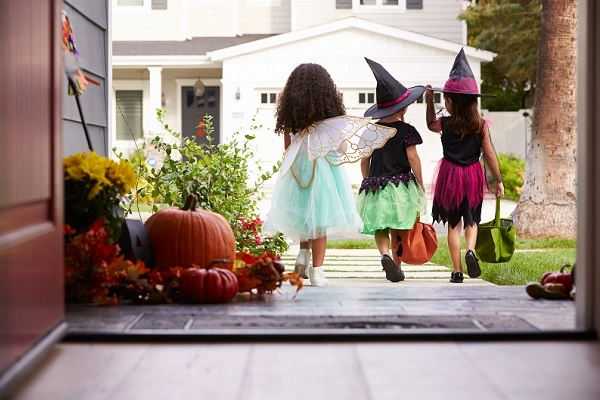Colorful food: It’s to dye for on Halloween

By Jessica Short
Is artificial food color bad for us? The jury is still out. But the safest, healthiest approach is to find natural additives if you just have to make something fun.
I certainly do (I have a little boy)—so I created the Halloween pumpkin cheese ball recipe below, with a side of little black bats.
Natural vs. artificial
Natural coloring comes from plants, even insects, rocks, and soil components, while artificial dyes are made from synthetic chemicals. Artificial dyes are everywhere—from breakfast cereal to soft drinks and vitamins.
The FDA has banned specific artificial colors, but plenty are still approved and on the market. Curious? Check your next bag of Skittles for lab-made colors from Red 40 to Yellow 5 and Blue 1.
Additives are used mainly to replace color lost when food is exposed to light, air, extreme temperatures, moisture, or storage—or to enhance naturally occurring colors, all to make food seem fresh and tasty. In fact, some Florida oranges are dipped in synthetic dyes to brighten and provide uniform color! Hot dogs often get a squirt of fake color to look more appetizing.
Food color rules vary around the globe, and the U.S. tends to have fewer restrictions than other developed countries. For example, Kraft’s mac and cheese was criticized for using yellow dyes 5 and 6 in the U.S. version while the English version uses no dye.
As a dietician, my rule is simple: Eat real food because it has more nutrients than processed food. Get your color from food itself—like bright red tomatoes or purple eggplant—because that color comes from nutrients. If special color is important, use plants. A major concern about artificial color is the purported link to hyperactivity in children, but studies are inconclusive enough not to force the FDA to require warning labels.
The fun part: color!
Here’s a quick guide to the rainbow of natural food colors you can add to your recipes:
RED: Pure beet juice, beet powder, 100 percent pomegranate juice.
PINK: Beet, cranberry and raspberry juice (just less of it).
ORANGE: Pure carrot juice, carrot powder, paprika.
YELLOW: Fresh turmeric juice, ground turmeric, saffron.
GREEN: Liquid chlorophyll, matcha powder, spirulina powder (use sparingly), juice from parsley, wheatgrass or spinach, or spinach or parsley powder.
BLUE: Blues and purples are the most difficult, either naturally or in a lab. Try red cabbage juice or stir a bit of baking soda in with red cabbage juice.
PURPLE: Purple sweet potatoes, pure blueberry juice, concentrated purple grape juice.
TAN: Bentonite clay powder (it’s an edible clay, but use sparingly).
BROWN: Cocoa powder, pure espresso, instant coffee granules, heavily steeped black tea, cinnamon.
BLACK: Black cocoa powder, activated charcoal powder (yes, it’s safe to eat and even beneficial!), squid ink.
You can find “how to” advice online, but the general idea to use a little heat and water with mashing to create intense shades. Natural colors will be more subdued than artificial, so experiment with quantities and combinations.
My favorite simple trick is to create pink frosting— just a few drops of beet juice create a lovely shade in frosting (and ice cream) without adding flavor. Choose powder if more liquid (from juice) might ruin the recipe or texture.
Or, find these brands to color frosting or holiday treats: Maggie's Naturals, India Tree, and Nature's Flavors. They use plant, fruit, and vegetable extracts.
Cheesy Good Fun, Halloween Style
Pumpkin and Bat Cheese Ball
Prep time: 15 minutes; makes 20 servings as an appetizer to be served with veggies or whole grain crackers.
Ingredients:
3 packages Neufchatel Cheese
3 tablespoons French onion soup mix
4 teaspoons Paprika (for the pumpkin)
2 capsules Activated charcoal (for the bat)
Basil leaves and green onion for pumpkin decor
Chips and almond slices to complete your bat
Directions: Combine cheese with soup mix. Scoop out 1/4 of cheese mixture and set aside for your bat. Add 2 teaspoons paprika to the pumpkin cheese. Combine well. Use spatula to form pumpkin into a ball and coat with remainder of paprika. Empty the activated charcoal capsules carefully into the bowl with the cheese for bat and use spatula to mix and shape. Decorate pumpkin with the basil and green onion stem. Add wings to your bat and use almonds for the face.
Nutrition facts: Serving size 14 g; calories, 36 (27 from fat); Total fat, 5% of daily value (no trans fat); Cholesterol, 10 mg (3%); Sodium, 134 mg (6%); Potassium, 15 mg (0%); Carbohydrates, 1.1 g (0%); Protein, 1.3 g; Vitamin A, 3%; Calcium, 1%.
Jessica Short is a registered dietitian for Salem health.